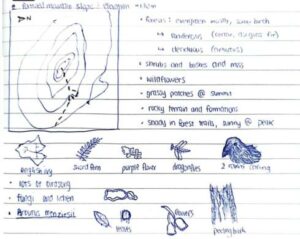My chosen area of study is Horth Hill Regional Park, in North Saanich, BC. The 36-hectare park is a forested mountain slope, approximately 130 m in elevation. This coastal temperate rainforest is filled with shrubs, ferns, mosses, lichens, fungi, and flowering grasses. I took a hike up one of the park trails on June 22nd, at 4:30 PM. It was a warm (21°C) and sunny summer afternoon, with low winds and few clouds. My starting elevation was around 40 m, where the forest was dense mostly with tall conifers such as Douglas firs (Pseudotsuga menziesii) and western red cedars (Thuja plicata). However, I noticed some scattered birch and arbutus (Arbutus menziesii) trees. Nearing the summit, rocky formations emerged and the coniferous forest thinned out, though there were more arbutus trees. Throughout the park, I heard many bird calls, but was only able to distinctly identify two nesting ravens. Additionally, I observed ants, woodlice, and blue dragonflies.
The distribution of the arbutus trees distinctly piqued my interest:
- Is the distribution of arbutus trees positively correlated with elevation?
- Does the distribution of arbutus trees change with elevation due to the differences in available sunlight?
- How is the distribution of arbutus trees impacted by temperatures at different elevations?
Apologies for the poor image quality as my camera is currently broken:





